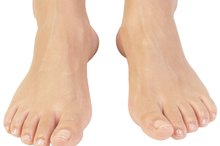Symptoms of Vitamin D Deficiency: Burning Feet
Vitamin D-2, or ergocalciferol, and vitamin D-3, or cholecalciferol, are variations of vitamin D that the body procures in different ways. Specifically, ergocalciferol is dietary, whereas the skin produces cholecalciferol. Sustained adequate intake of vitamin D can prevent hypertension, osteoporosis, many autoimmune diseases and cancer, but the primary purpose of the nutrient is to facilitate the absorption of dietary calcium and phosphorus. Vitamin D deficiencies do not often render symptoms, and burning feet are particularly unlikely.
Vitamin D Deficiency
A deficiency in vitamin D may produce no symptoms, but bone pain and muscle weakness may be an indication. On the other hand, bone pain and muscle weakness are an indication of several health complications, so it may be prudent to determine whether you're at risk and see a doctor for tests if you suspect a vitamin D deficiency. Those particularly at risk include those with fat malabsorption, limited sun exposure, dark skin and a history of gastric bypass surgery. Seniors and breastfed babies are also at risk for developing a vitamin D deficiency, but mothers and seniors who supplement their diets with extra vitamin D can prevent this deficiency. The elderly should consume up to 10 micrograms of vitamin D per day, while everyone else should have 5 micrograms.
- A deficiency in vitamin D may produce no symptoms, but bone pain and muscle weakness may be an indication.
- On the other hand, bone pain and muscle weakness are an indication of several health complications, so it may be prudent to determine whether you're at risk and see a doctor for tests if you suspect a vitamin D deficiency.
Secondary Calcium Deficiency
Magnesium Deficiency Symptoms in Women
Learn More
A vitamin D deficiency can lead to a secondary calcium deficiency. According to an article in the July 2007 "New England Journal of Medicine," the body is capable of absorbing only 10 to 15 percent of dietary calcium in the absence of vitamin D. Accordingly, a secondary calcium deficiency can occur despite an otherwise adequate calcium intake. The body stores 99 percent of calcium in bones, making it essential for bone health. This is why a deficiency in calcium can lead to osteomalacia, or chronic bone pain and osteoporosis, which is a combination of chronic bone weakness and bone pain that can be both crippling and deforming. However, calcium is also essential for the contraction and expansion of muscles, enzyme and hormone excretion, and nerve function. Thus, a calcium deficiency can cause nerve complications, which can manifest as burning feet but more often occurs as tingling, numbness and nonspecific pain.
- A vitamin D deficiency can lead to a secondary calcium deficiency.
- This is why a deficiency in calcium can lead to osteomalacia, or chronic bone pain and osteoporosis, which is a combination of chronic bone weakness and bone pain that can be both crippling and deforming.
Secondary Phosphorus Deficiency
The 2007 "New England Journal of Medicine" indicates that the body can absorb up to 60 percent of dietary phosphorus without vitamin D and 80 percent with an adequate intake of vitamin D. Phosphorus deficiencies have several symptoms akin to vitamin D and calcium deficiencies, including loss of appetite, muscle weakness, bone pain, osteomalacia, numbness or tingling, and difficulty walking. A phosphorus deficiency can also cause anemia, though, which affects nerve endings and can lead to the sensation of burning feet, according to the University of Maryland Medical Center. Therefore, burning feet can conceivably result from a vitamin D deficiency that leads to a secondary phosphorus deficiency.
Bottom Line
Can Vitamin B Deficiencies Cause Foot Pain?
Learn More
A vitamin D deficiency that has not yet produced complications with other nutrients is not likely to exhibit symptoms. Symptoms do occur as the condition worsens and leads to secondary deficiencies in calcium and phosphorus. Although a deficiency in calcium can possibly cause burning feet, it is most likely that burning feet following a lack of vitamin D consumption or production result from a phosphorus deficiency. Other causes of burning feet include alcoholism, athlete's foot, chronic kidney failure, chemotherapy, HIV or AIDS, tarsal tunnel syndrome, diabetic neuropathy and hypothyroidism.
- A vitamin D deficiency that has not yet produced complications with other nutrients is not likely to exhibit symptoms.
- Although a deficiency in calcium can possibly cause burning feet, it is most likely that burning feet following a lack of vitamin D consumption or production result from a phosphorus deficiency.
Related Articles
References
- Linus Pauling Institute: Vitamin D
- Office of Dietary Supplements: Vitamin D
- The New England Journal of Medicine: Vitamin D Deficiency
- Linus Pauling Institute: Phosphorus
- University of Maryland Medical Center: Anemia
- MedlinePlus.com: Rickets
- Institute of Medicine (US) Committee to Review Dietary Reference Intakes for Vitamin D and Calcium; Ross AC, Taylor CL, Yaktine AL, et al., editors. Dietary Reference Intakes for Calcium and Vitamin D. Washington (DC): National Academies Press (US); 2011. 3, Overview of Vitamin D.
- Roy S, Sherman A, Monari-Sparks MJ, Schweiker O, Hunter K. Correction of low vitamin D improves fatigue: Effect of correction of low Vitamin D in fatigue study (EViDiF study). N Am J Med Sci. 2014 Aug;6(8):396-402. doi: 10.4103/1947-2714.139291
- Wong SK, Chin KY, Ima-Nirwana S. Vitamin D and Depression: The evidence from an indirect clue to treatment strategy. Curr Drug Targets. 2018;19(8):888-97. doi: 10.2174/1389450118666170913161030
- Nair R, Maseeh A. Vitamin D: The "sunshine" vitamin. J Pharmacol Pharmacother. 2012;3(2):118-26. doi:10.4103/0976-500X.95506
- Meena N, Singh Chawla SP, Garg R, Batta A, Kaur S. Assessment of vitamin D in rheumatoid arthritis and its correlation with disease activity. J Nat Sci Biol Med. 2018;9(1):54-58. doi:10.4103/jnsbm.JNSBM_128_17
- Fares A. Winter cardiovascular diseases phenomenon. N Am J Med Sci. 2013;5(4):266-79. doi:10.4103/1947-2714.110430
- Porojnicu AC, Dahlback A, Moan J. Sun exposure and cancer survival in Norway: changes in the risk of death with season of diagnosis and latitude. Adv Exp Med Biol. 2008;624:43-54. doi: 10.1007/978-0-387-77574-6_4
- Holick MF et al. Evaluation, treatment, and prevention of vitamin D deficiency: an Endocrine Society clinical practice guideline. J Clin Endocrinol Metab. 2011 Jul;96(7):1911-30. doi: 10.1210/jc.2011-0385
- Ross AC et al. The 2011 report on dietary reference intakes for calcium and vitamin D from the Institute of Medicine: what clinicians need to know. J Clin Endocrinol Metab. 2011 Jan;96(1):53-8.
- Pilz et al. Vitamin D testing and treatment: a narrative review of current evidence. Endocr Connect. 2019 Feb 1;8(2):R27-R43. doi: 10.1530/EC-18-0432
- National Institutes of Health Offices of Dietary Supplements. Vitamin D fact sheet. Updated August 7, 2019.
Writer Bio
Naomi Parks has been a freelancing professional since 2004. She is a biochemist and professional medical writer with areas of interest in pulmonology, pharmaceuticals, communicable diseases, green living and animals. She received her Bachelor of Arts in biological anthropology from San Francisco University and her Master of Science in biochemistry from Pace University.









